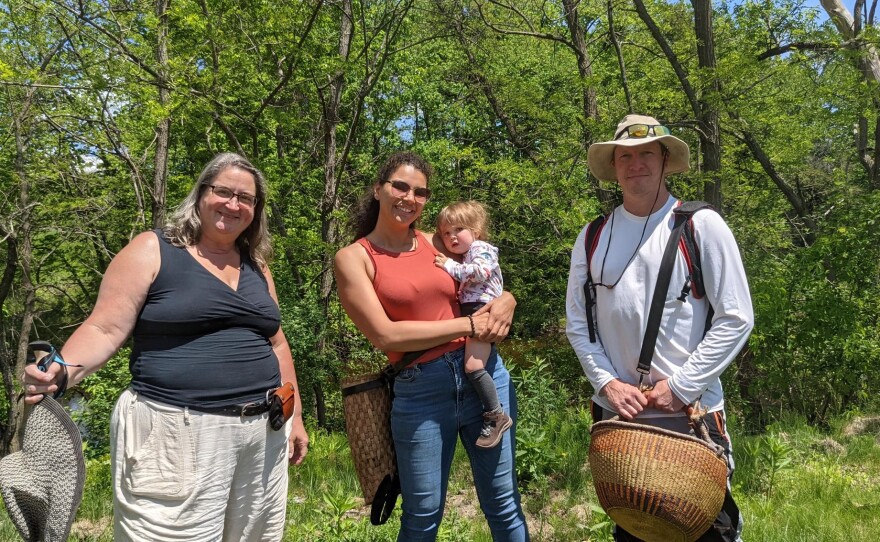Editor’s note: We highly recommend listening to this story.
Somewhere off the highway in Western New Hampshire, I’m meeting with a group of foragers in a parking lot at an undisclosed location.
Lush trees line the area and a river runs nearby. It’s what Christine Gagnon, a foraging educator from Southern New Hampshire, calls “a little heaven on Earth, minus the ticks.”
We haven’t left the parking lot, and Christine and others in the group are finding trail snacks. They point out dead nettle and grape vines draping along a black locust tree.

Melinda Christian, fellow forager on this trip, says one of her favorite spring edibles is the flower on the black locust tree. Though, she warns the rest of the tree is toxic.
She says what she loves about foraging this time of year is that she can find where edibles will be growing in later seasons. In the fall, people can have a hard time finding fruit trees or plants like Japanese knotweed or autumn olives, which are in bloom now in the spring.
You don’t have to go deep in the woods to find edible plants and mushrooms.
“There’s so much foraging that can be done in the city, like urban foraging or suburban foraging,” says Christine.
But she says it’s necessary to really understand which plants and mushrooms you’re harvesting. It’s why I’m tagging along with experienced foragers today. Our main objective is to find fiddleheads, which is why we’re keeping our exact location a secret.
“It’s one of the last fiddlehead spots that I know of that other people don’t seem to harvest from,” says Christine.
Fiddleheads are tightly coiled greens that are harvested from ostrich ferns. They’re a popular spring edible.
We walk under a bridge and alongside the river until we reach a large clearing with grass so tall it meets my hips. We’ve walked maybe half a mile from the highway, but it’s like a whole other world. We’re surrounded by all kinds of plants. Pollinators are flying around, and there are lots of ticks too.
Christine points out an ostrich fern nearby. The leaves almost look like feathers.
“They have a large groove kind of like celery up the center,” she says. “That’s another identifier there.”
There we find our first fiddlehead, but we don't pick it. The group picked fiddleheads in this area the week before, and we don’t want to overharvest. Christine says it’s important to only pick a few fiddleheads off one fern at a time. If you pick too many, the fern will die.
We pass by a tree with a pheasant back mushroom, larger than my head. A few yards past that, we find ourselves in a sea of ostrich ferns, with plenty of fiddleheads to harvest sustainably.

There’s so much to be found on these foraging trips. Melinda says they can be day long adventures. Last year, she and Christine hiked Mount Tecumseh looking for a particular kind of mushroom.
“It’s supposed to be a four hour hike,” says Melinda. “It took us ten hours to get up there and it’s because of how much stuff we found.”
Christine says it’s not just about the finds, but also the people you meet along the way. This group of friends I’m with today were all brought together through foraging. They are part of a larger online community where people share recipes and help each other identify plants and mushrooms.
“I mean I hate to be corny, but the community aspect of foraging has been just as valuable, if not more valuable than the foraging itself,” said Christine.
She and Melinda agree it’s been life changing.









